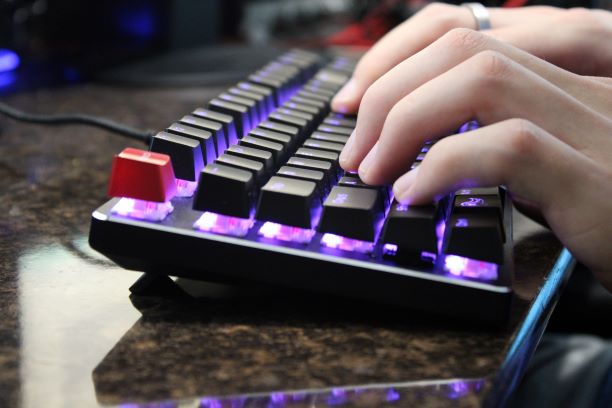
Whether you’re a professional typist or someone who spends a lot of time on the computer, learning about the effects of your posture and typing experience can be very beneficial for a healthier future. That’s where typing ergonomics comes in.
You might be wondering, what is typing ergonomics, and why is it important? Well, that’s precisely what I’m here to tell you.
In this article, I’m going to talk about typing ergonomics, the drawbacks of uncomfortable typing experiences, how ergonomic keyboards work and how ergonomic typing experiences benefit your posture, and overall health in the long run. So, make sure you read this article till the end.

Table of Contents
What is Typing Ergonomics?
Typing ergonomics deals with the accurate and comfortable position of the hands, fingers, angling of the shoulders, their width, spine, and the overall posture of the body while typing on a keyboard.
It may sound simple but it involves a lot of research and then coming up with the ideal position that won’t put strain on your muscles and joints.
It is essential that you maintain typing ergonomics while at work or playing games on your room computer because your typing experience has huge effects on your future health at the end of the day.
In the last century, when keyboards and typing devices were invented, ergonomics was not paid a lot of attention. Still, now there are better ergonomic devices that can enhance the typing experience, and you should definitely utilize them.
Drawbacks of an Uncomfortable Typing Experience
Typing may seem like a small activity in your daily routine, but trust me when I say this. Over time, uncomfortable typing experiences where your fingers are not in the natural position or posture can cause serious joint and bone issues.
Let’s take an example. If you’re sitting at your computer desk and you’re about to type. Take a look at your overall position. Do you have to raise your shoulders to reach the keyboard? Do you have to bend your hands to place your fingers on the keys accurately? Do you have to reduce your natural shoulder width to adjust to the small compact keyboard you’re using? If yes, then you’re experiencing a non-ergonomic typing environment.
The bad thing about uncomfortable typing experiences is that what may seem harmless to you, can cause adverse health effects shortly. Diseases like Carpal Tunnel Syndrome, Arthritis, and many others are common among the people who periodically use non-ergonomic typing devices in their everyday routine, which is something you should definitely avoid.
Ergonomic Keyboards
To solve non-ergonomic typing, peripheral companies sat shoulder to shoulder, and after years of struggle and research, a device was created known as an ergonomic keyboard.
An ergonomic keyboard is a typing device designed to fit the natural posture and arm positions so any discomfort, muscle strain, stress, and tension can be ruled out, ultimately providing a safe and disease-less future typists and avid computer users out there.
There are many different techniques in use for making keyboards ergonomic. A very famous technique is the split keyboard method. Split keyboard design places the keys on a keyboard in two sections, usually mapped in a V shape. This V shape allows the arms and fingers to be placed directly onto the keys without any unnatural bend or turn in the wrist.
Another commonly used type of ergonomic keyboard is the contoured keyboard. In this keyboard, the two sections of the split keyboard are contoured and placed on a negative incline to avoid unnecessary finger raising and wrist bending, which is great.
Similarly, ergonomic wrist pads are also introduced in standard keyboards that allow users to type and play games with their keyboards for long periods of time without experiencing any discomfort or pain in their wrists.
Simply put, ergonomic keyboards have made typing ergonomics very commonly considered by computer users, and this is a great change. There are other kinds of ergonomic keyboards, like handheld ones and vertical keyboards, etc., that you can use to ensure typing ergonomics is upheld in your typing experiences.
5 Benefits of Using an Ergonomic Keyboard
We know the importance of typing ergonomics in the life of a daily computer user. But what are the advantages and benefits of using an ergonomic keyboard? You might be wondering. Well, lucky for you, I’ve made a list of the benefits of using an ergonomic keyboard. Let’s take a look at it.
- Joints remain relaxed – When you’re typing on an ergonomic keyboard, you’re simply reducing the pain and bending of the arms and fingers. This will help to keep your joints relaxed and muscles free of any pressure or tension.
- Wrist stays calm – If your ergonomic keyboard comes with a wrist pad, you’ll be able to use the keyboard without a problem for long hours as your wrist will remain cushioned and calm due to the softness of the rest underneath it.
- More productivity – If your joints, muscles, and wrist aren’t constantly hurting, you won’t need to take breaks all the time, and that will allow you to be more productive on your computer, helping you play better and work better.
- Easy to Use – If you compare the ease of use of an ergonomic keyboard with that of a normal standard keyboard, the typing experience and ease of typing is much better on an ergonomic keyboard.
- Better than Standard Keyboards – When it comes to better response rate, faster typing, among other benefits, ergonomic keyboards are far superior to standard non-ergonomic keyboards commonly used all around the world.
Conclusion
Typing ergonomics is incredibly vital if you ask me. Ensuring that you take all the measures to keep the typing ergonomics of your keyboarding experience well-maintained is a crucial step of keyboard usage.
I hope you learned a lot in this guide about the importance of typing ergonomics and that you’ll buy an ergonomic keyboard for office and home usage soon. I wish you the best in your upcoming keyboarding experience.

